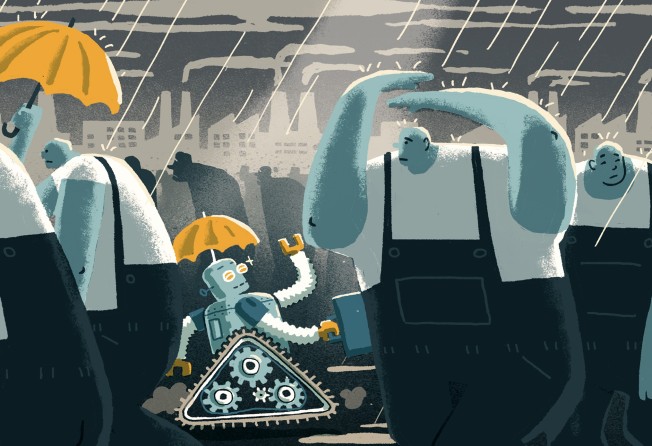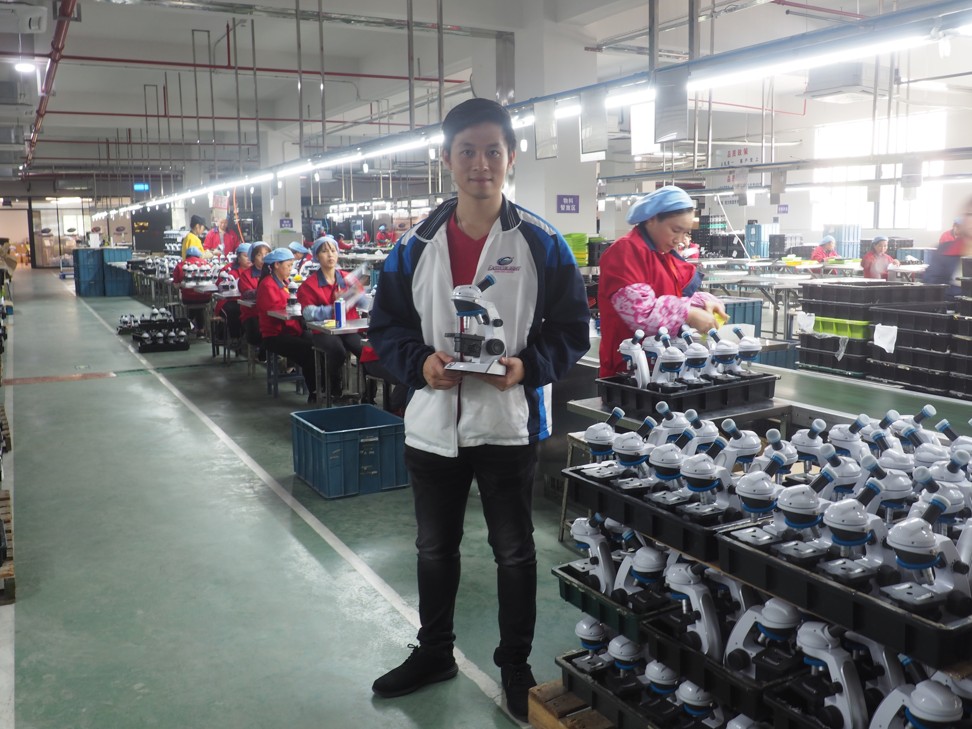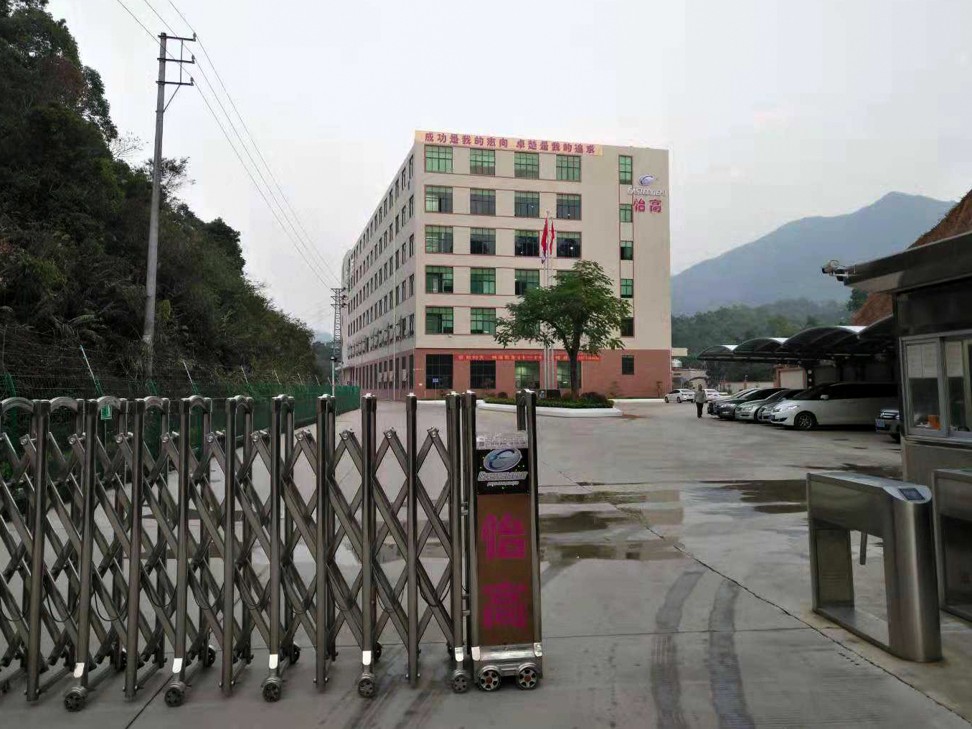Trade war tariff threat, rising costs drives Hong Kong manufacturer to automate Chinese factory to survive
- Eastcolight’s new 70 million yuan (US$10 million) factory in Guangdong province has reduced its workforce to 300 from a peak of 2,000 by investing in 50 robotic arms
- Its capacity is set to increase by 25 per cent this year as the company seeks to focus on China’s domestic market

A factory in the southern Guangdong province, just over the border from the casino hub of Macau, offers a new face of “Made in China”. Gone are the army of uniformed Chinese migrant workers manning manual production lines, in their place an automated intelligent production centre equipped with 50 robotic arms that rarely take breaks or make mistakes.
The new factory, belonging to Hong Kong-based toymaker Eastcolight in the town of Shenwan, which is part of the city of Zhongshan, has been in operation since early last year. Its newly installed solar panels are likely to generate a tenth of the plant’s electricity, while dormitories with private amenities and exercise equipment are provided for employees.
The labour force has been trimmed to 300 from a peak of 2,000, significantly reducing production costs to remain competitive, even though the capacity is set to increase by 25 per cent to 600,000 units per month this year.
Faced with the developing trade war between China and the United States, it was the final push Johnny Sze Chun-hong, Eastcolight’s director and vice general manager who inherited the factory’s management from his parents, needed to make the one-off investment of 70 million yuan (US$10 million).
Sze still needed to keep a close eye on the plans by US President Donald Trump to levy additional tariffs on Chinese imports before Christmas over fears the duties, which were eventually halted as part of the phase one deal discussions, would raise the retail price of his toy microscopes and telescopes.
“We thought it was pure luck that allowed us to continue a manufacturing model from 30 years ago,” the 28-year-old Sze said. “Then the trade war got our customers worrying, and that forced us towards automation.”
The choice of the Sze family and Eastcolight, having opened their first factory in China in the sleepy town best known for its pineapple farms in 2000, sheds light on how Trump’s trade war is transforming the manufacturing sector in China.
There are, like Trump claimed in the summer of 2019, manufacturers who have been seeking to move or outsource part of their production into other markets such as Vietnam and Bangladesh over the past years due to rising labour and land costs in China. And while Trump’s tariffs have accelerated the process in some cases, there are other manufacturers who have decided to hold onto their access to China’s advanced production systems and vast domestic market.

China’s National Development and Reform Commission (NDRC), the state economic planning agency, said in a statement in December that “a small group” of businesses have relocated operations from China to avoid “impacts from trade disputes”, but that most businesses have decided to stay due to China’s developed industrial system and deep talent pool.
For the Sze family, the choice to remain in China was by default. Johnny Sze Chun-hong’s father, Andy Sze Wei-hung, who co-founded Eastcolight with his wife in 1991, had been a high school teacher in the Chinese province of Fujian, and his teaching experiences led him to realise the importance of a good education. The desire to stir students’ interest to learn was one motivation for him to create toys that could “bring education into play”, according to his son.
Like many investors from Hong Kong and Taiwan, Sze senior built a factory in the Pearl River Delta in 2000, a year before China’s entry into the World Trade Organisation. Blessed by China’s cheap labour and access to the global markets, Eastcolight’s business quickly expanded to 500 production items, sold to 110 countries across the world.

But unlike most Chinese assembly manufacturers that made semi-finished products for another company, Sze’s plant manufactured toys under its own brand and supply chain, from material making, to moulding, to painting and packaging. At the same time, the previous factory provided dormitory rooms for its workers, with 12 employees crammed into each room without hot water or air conditioning.
These conditions, though, are no longer appealing to China’s young generation of migrant workers, and with the monthly average salary in Guangdong having increased by about 700 per cent in the last two decades, many factories have been forced to turn to robotics and smart production. To address this, Eastcolight have also upgraded their facilities for its employees within its new factory.
“There is no country like China that can give you such a hard working labour force,” Sze said. “We had considered relocating the factory to southeast Asian countries, but they do not have a population that is as big so their wages could catch up very easily. Their production isn’t as efficient.”
We had considered relocating the factory to southeast Asian countries, but they do not have a population that is as big so their wages could catch up very easily. Their production isn’t as efficient
China’s increasing income levels and loosening of family planning policies also persuaded Sze to stay closer to a substantial toy market. Augmented reality toys that combine mobile phone applications with physical toys are particularly receptive to Chinese customers, according to Sze.
As of 2017, there were around 233 million children under the age of 14 in China, which was the same year it began the full implementation of its two-child policy.
“China is very receptive to application toys. We never had a client anywhere in the world that could sell 5,000 of our units in just two days. This is really an amazing trend,” Sze added.
The very reasons that have persuaded Eastcolight to stay and upgrade to better tap into China’s significant customer base are also offering the government confidence that it can manage the fallout from a trade war with the US, which accounted for almost one-fifth of China's total exports before the trade war, when it was by some distance the biggest buyer of Chinese goods. Exports have, though, subsequently dropped off

According to data from market research company, Euromonitor, the total retail sales of toys and games in China soared from 135.6 billion yuan (US$19.5 billion) in 2013 to 324.1 billion yuan (US$46.5 billion) in 2018, an average annual growth rate of 19.1 per cent.
“China has 170 million people who have high education or professional training, and China produces 8 million new college and university graduates every year. Some countries may have lower labour costs, but can their labour match Chinese workers in terms of efficiency, organisation and discipline?” China’s NDRC said.
In addition, China can now make almost every industrial product at a reasonable cost, making it an ideal place to assemble and manufacture goods, the agency added.
Adran Chong Pak-yan, the chief executive at Soap Studio Company, also decided to continue making his collectible action figures in China despite the trade war, even though the US is a key market. With licences from American movie companies such as Disney, he sells Marvel superheroes and Looney Tunes characters at prices ranging between HK$200 (US$26) to HK$5,000 (US$640) per item.
“Toy exports from China will demand a higher quality, which cannot be made in Southeast Asia,” Chong said. “We didn’t move our production because we are making medium to high-end products.”
A phase one trade agreement is set to be signed in early January, with the US agreeing to scrap plans to impose 15 per cent tariffs on US$156 billion of products from China on December 15, offering a reprieve to Chinese exports of toys and games that were included on the threatened tariff list.
Louis Chan, assistant principal economist at the Hong Kong Trade Development Council, remains cautious of the geopolitical uncertainty, predicting a rather weak export performance in Hong Kong’s toy sector through the beginning of 2020 after it recorded an almost 30 per cent drop in the first 10 months of 2019.
“There is a positive news from the trade war, but the question is if this can immediately brighten the outlook,” Chan said.
Purchase the China AI Report 2020 brought to you by SCMP Research and enjoy a 20% discount (original price US$400). This 60-page all new intelligence report gives you first-hand insights and analysis into the latest industry developments and intelligence about China AI. Get exclusive access to our webinars for continuous learning, and interact with China AI executives in live Q&A. Offer valid until 31 March 2020.